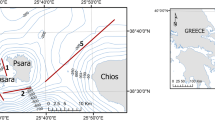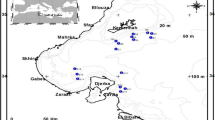Abstract
In 1980 a long-term study of the fishery resources of the San Francisco Bay estuary was initiated in an effort to delineate the importance of freshwater inflow to fish and invertebrate abundance and distribution in the bay. An analysis of the trawl data collected between January 1980 and December 1982 illustrates the influence of the timing and magnitude of freshwater inflows on fish fistribution and abundance in this estuary from the perspective of monthly, seasonal and annual time scales. Normally found in the delta, Suisun Bay and San Pablo Bay during periods of increased salinity, pelagic species moved downstream after the two peak flows studied, while demersal species usually found in Central San Francisco Bay moved upstream. Such upstream movements may be due in part to transport by strong density-driven currents.
Timing and magnitude of monthly catches of some species varied on a seasonal cycle coincident with variations of freshwater inflow. Most species, especially the marine species, showed no consistent cycle of monthly catches. In the wet years of 1980 and 1982 the distributions of freshwater, estuarine and anadromous species were extended downstream into San Pablo, Central and South San Francisco Bays and some marine species, including the flatfish, were more abundant in the upstream areas. In the dry year of 1981 when bay salinities were higher, few marine species extended their distributions upstream into San Pablo and Suisun Bays. Jacksmelt was the only fish of the 15 most abundant species with its peak abundance in 1981. Most marine species were more abundant in the San Francisco Bay estuary in the wet years.
Similar content being viewed by others
References
Aplin, J. A., 1967. Biological survey of San Francisco Bay 1963–1966. California Department of Fish and Game, Marine Resources Operations Laboratory No. 67-4: 24 pp.
Blaber, S. J. M. & T. G. Blaber, 1980. Factors affecting the distribution of juvenile estuarine and inshore fish. J. Fish. Biol. 17: 143–162.
California Department of Water Resources, 1976. Delta water facilities. California Department of Water Resources, Bulletin 76, 119 pp.
California Department of Water Resources, 1980. Water conditions in California. California Department of Water Resources, Bulletin 120-80, 45 pp.
California Department of Water Resources, 1981. Water conditions in California. California Department of Water Resources, Bulletin 120-81, 50 pp.
California Department of Water Resources, 1982. Water conditions in California. California Department of Water Resources, Bulletin 120-82, 47 pp.
Chadwick, H. K., 1964. Annual abundance of young striped bass Roccus saxatilis, in the Sacramento-San Joaquin Delta, California. California Fish Game 50: 69–99.
Chadwick, H. K., D. E. Stevens, and L. W. Miller, 1977. Some factors regulating the striped bass population in the Sacramento-San Joaquin Estuary, California. In W. Van Winkle (ed.), Proc. of the Conference on Assessing the Effects of Power-Plant-Induced Mortality in Fish Populations. Pergamon Press: 18–35.
Cheng, R. T. & T. J. Conomos, 1980. Studies of San Francisco Bay by the U. S. Geological Survey. Proc. Inst. of Environ. Sci. 1980: 299–303.
Conomos, T. J., 1979. Properties and circulation of San Francisco Bay waters. In T. J. Conomos (ed.), San Francisco Bay: The Urbanized Estuary. Pacific Division, American Association for the Advancement of Science, San Francisco, California: 47–84.
Herrgesell, P. L., D. W. Kohlhorst, L. W. Miller & D. E. Stevens, 1981. Effects of freshwater flow on fishery resources in the Sacramento-San Joaquin Estuary. In R. D. Cross and D. L. Williams (eds.), Proceedings of the National Symposium on Freshwater Inflow to Estuaries. U. S. Fish and Wildlife Service, Washington, D. C.: 71–87.
Hoese, H. D., B. J. Copeland, F. N. Moseley & E. D. Lane, 1968. Fauna of the Aransas Pass Inlet, Texas. III. Diel and seasonal variations in trawlable organisms of the adjacent area. Texas J. of Sci. 20: 33–60.
Kjelson, M. A., P. F. Raquel & F. W. Fisher, 1980. Influences of freshwater inflow on chinook salmon (Oncorhynchus tshawytscha) in the Sacramento-San Joaquin Estuary. In R. D. Cross and D. L. Williams (eds.), Proceedings of the National Symposium on Freshwater Inflow to Estuaries. U. S. Fish and Wildlife Service, Washington, D. C.: 88–108.
Kjelson, M. A., P. F. Raquel & F. W. Fisher, 1982. Life history of fall-run juvenile chinook salmon, Oncorhynchus tshawytscha, in the Sacramento-San Joaquin Estuary, California. In V. S. Kennedy (ed.), Estuarine Comparisons. Academic Press, New York, N.Y.: 393–411.
Kohlhorst, D. W., 1980. Recent trends in the white sturgeon population in California's Sacramento-San Joaquin Estuary. California. Fish Game 66: 210–219.
Livingston, R. J. & J. L. Duncan, 1979. Climatological control of a North Florida coastal system and impact due to upland forestry management. In R. J. Livingston (ed.), Ecological Processes in Coastal Marine Systems. Plenum Press, New York, N.Y.: 339–379.
Mackiernan, G. B., D. F. Bleil, and G. B. Shea, 1982. Chesapeake Bay low freshwater inflow study, biota assessment. Phase II, Main Report. U.S. Army Corps of Engineers, 207 pp.
Miller, D. J. & R. N. Lea, 1972. Guide to the coastal marine fishes of California. California Department of Fish and Game, Bulletin 157. 249 pp.
Moyle, P. B., 1976. Inland fishes of California. University of California Press, Berkeley, C.A., 405 pp.
Porterfield, G., N. L. Nanley & C. A. Dunnam, 1961. Fluvial sediments transported by streams tributary to the San Francisco Bay area. U. S. Geol. Surv. Open-File Rep., 70 pp.
Reid, G. K., 1957. Biologic and hydrographic adjustment in a disturbed Gulf Coast estuary. Limnol. Oceanogr. 2: 198–212.
Richardson, S. L. & W. G. Pearcy, 1977. Coastal and oceanic fish larvae in an area of upwelling off Yaquina Bay, Oregon. Fish. Bull. 75: 125–145.
Sheridan, P. F. & R. J. Livingston, 1979. Cyclic trophic relationships of fishes in an unpolluted river-dominated estuary in North Florida. In R. J. Livingston (ed.), Ecological Processes in Coastal Marine Systems. Plenum Press, New York, N.Y.: 143–161.
Skinner, J. E., 1962. An historical review of the fish and wildlife resources of the San Francisco Bay area. California. Department of Fish and Game Water Projects Branch Report No. 1, 225 pp.
Stevens, D. E., 1977. Striped bass (Morone saxatilis) year class strength in relation to river flow in the Sacramento-San Joaquin Estuary, California. Trans. Am. Fish. Soc. 106: 34–42.
Stevens, D. E., 1979. Environmental factors affecting striped bass (Morone saxatilis) in the Sacramento-San Joaquin Estuary. In T. J. Conomos (ed.), San Francisco Bay: The Urbanized Estuary. Pacific Division, American Association for the Advancement of Science, San Francisco, California: 469–478.
Stevens, D. E. & L. W. Miller, 1983. Effects of flow on abundance of young chinook salmon, American shad, longfin smelt, and delta smelt in the Sacramento-San Joaquin River system. N. Am. J. Fish. Mgt. 3: 425–437.
Striped Bass Working Group, 1982. The striped bass decline in the San Francisco Bay-Delta Estuary. California State Water Resources Control Board. Sacramento, California, 58 pp
Texas Department of Water Resources, 1982. The influence of freshwater inflows upon the major bays and estuaries of the Texas gulf coast-executive summary. Texas Department of Water Resources. LP-115, 53 pp.
Turner, J. L. & D. W. Kelley (Compilers), 1966. Ecological studies of the Sacramento-San Joaquin Delta, Part II. Fishes of the Delta. California Dept. Fish Game. Fish. Bull. 136: 168 pp.
U.S. Army Corps of Engineers, 1980. Final environmental statement, operation of the delta pumping plant. U.S. Army Corps of Engineers, Sacramento District. 153 pp.
Walters, R.A., R. T. Cheng & T. J. Conomos, 1985. Time scales of circulation and mixing processes of San Francisco Bay waters. Hydrobiologica (This volume).
Wenner, E. L., M. H. Shealy, Jr. & P. A. Sandifer, 1982. A profile of the fish and decapod crustacean community in a South Carolina estuarine system prior to flow alteration. National Oceanic and Atmospheric Administration Tech. Rept. National Marine Fisheries Service, SSRF-757, Charleston, South Carolina, 17 pp.
Wenner, E. L., W. P. Coon, M. H. Shealy, Jr., and P. A. Sandifer, 1984. A five-year study of seasonal distribution and abundance of fishes and decapod crustaceans in the Cooper River and Charleston Harbor, South Carloina, prior to diversion. National Oceanic and Atomspheric Administration Tech. Rept. National Marine Fisheries Service, SSRF-782, 16 pp.
Author information
Authors and Affiliations
Rights and permissions
About this article
Cite this article
Armor, C., Herrgesell, P.L. Distribution and abundance of fishes in the San Francisco Bay estuary between 1980 and 1982. Hydrobiologia 129, 211–227 (1985). https://doi.org/10.1007/BF00048696
Issue Date:
DOI: https://doi.org/10.1007/BF00048696




